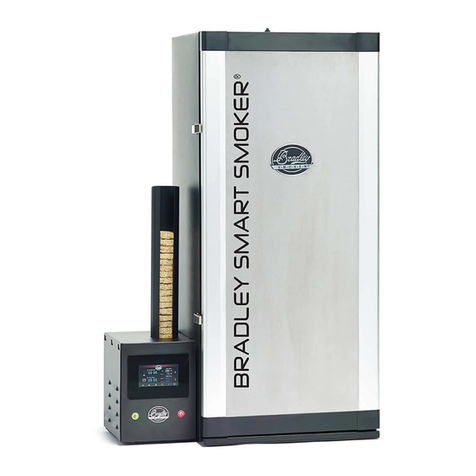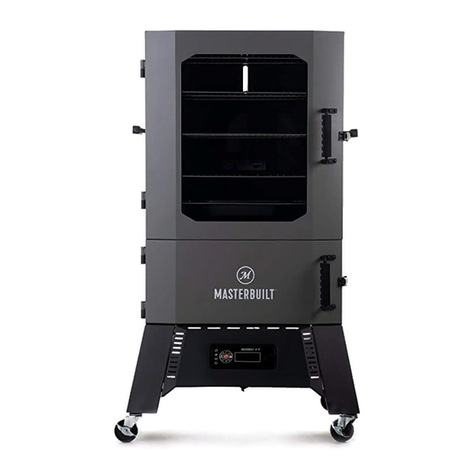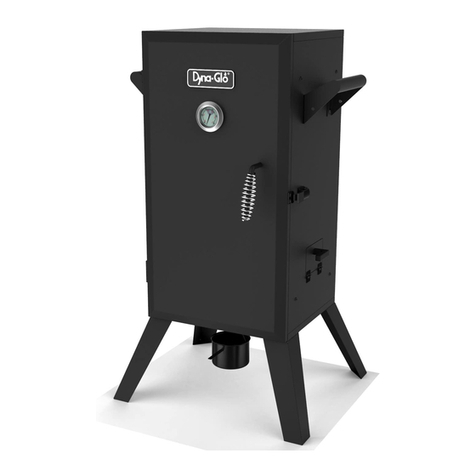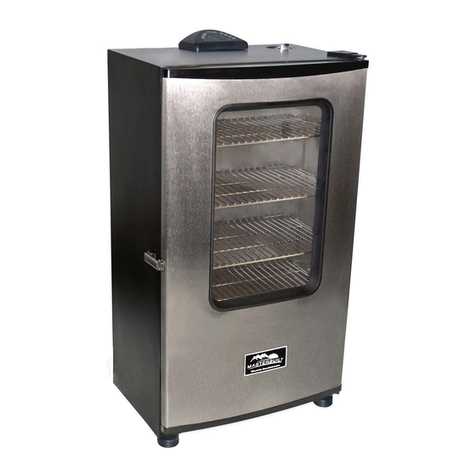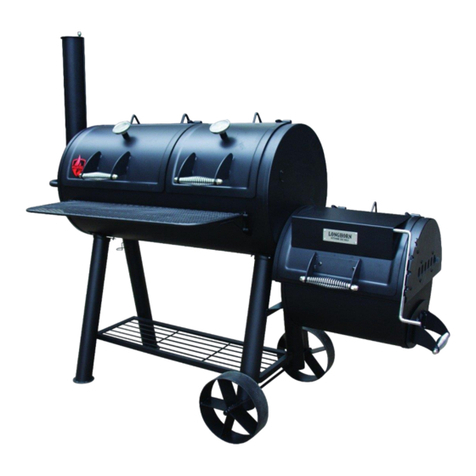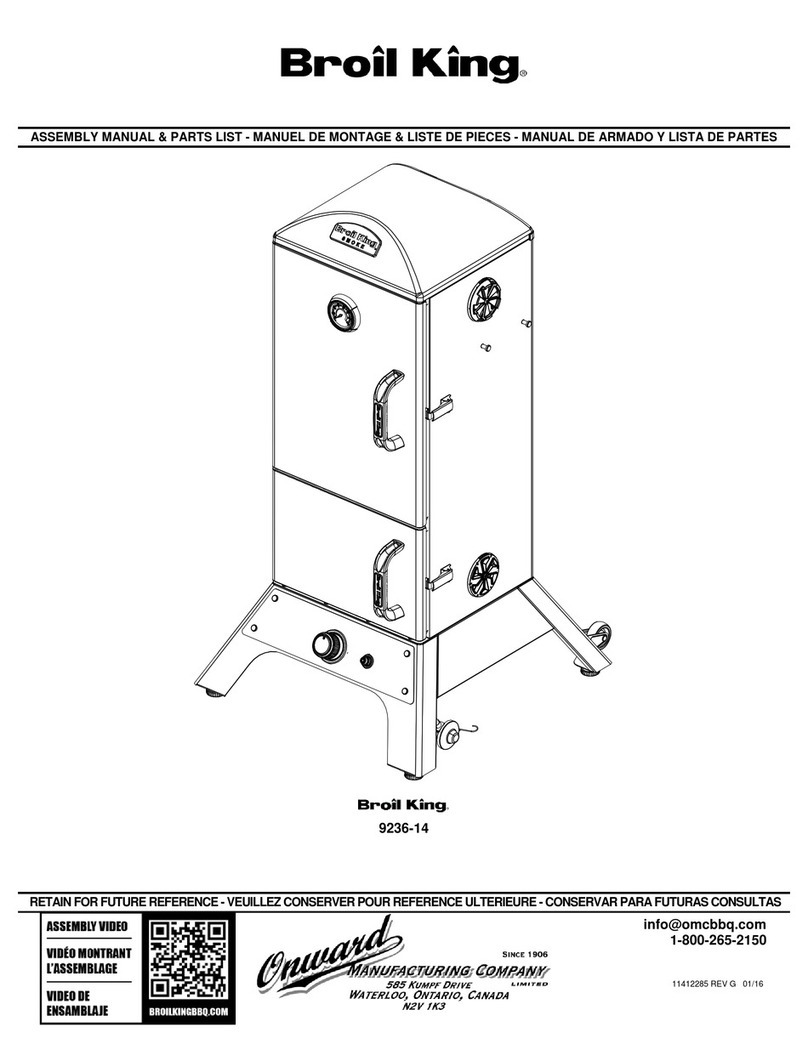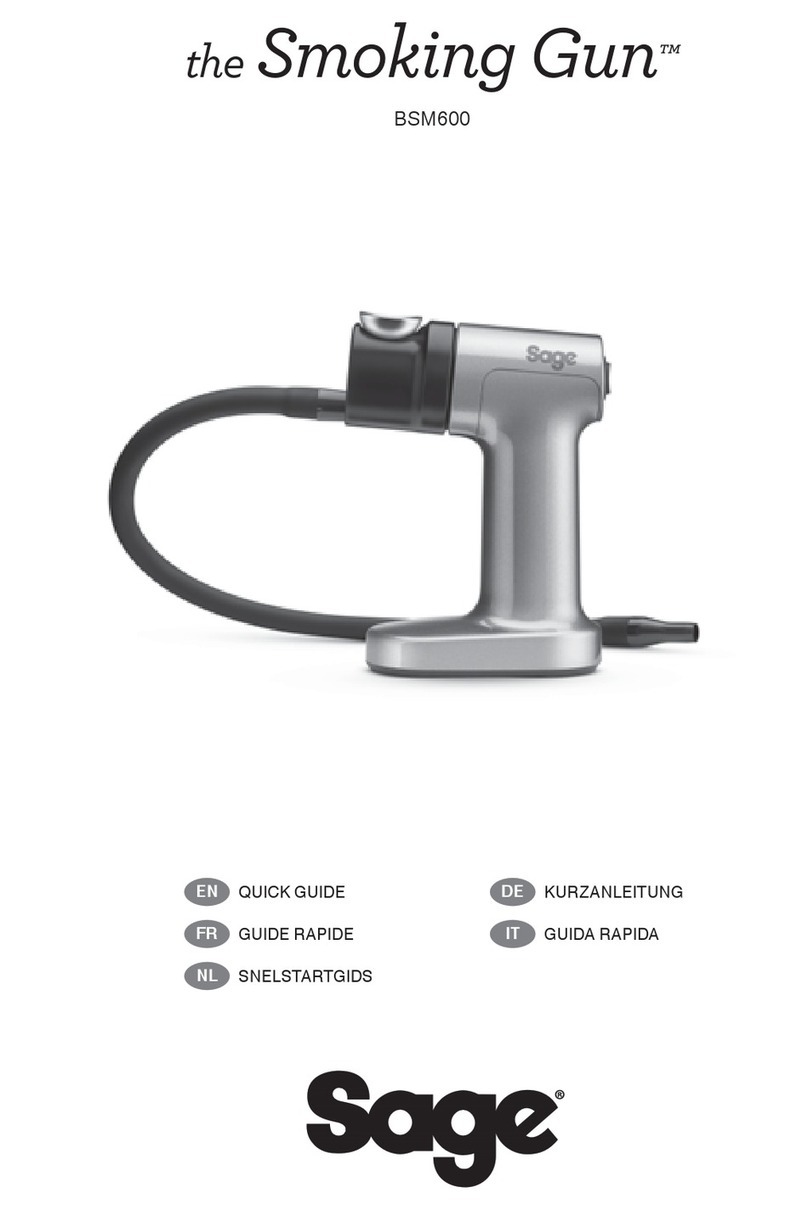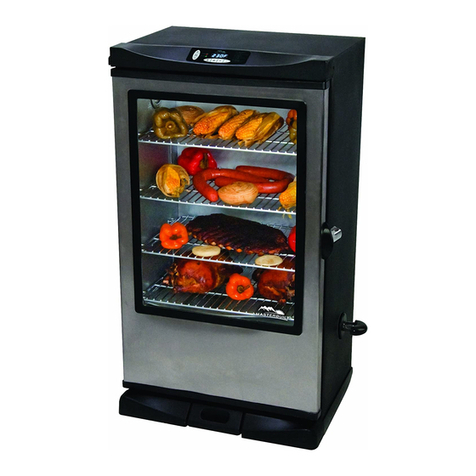ProBBQ Amigo User manual

This booklet is a brief guide on water smoking, more
details can be found at:
www.probbq.co.uk –Home of ProQ Smokers.
www.talkbbq.co.uk –BBQ Forum.
Further contact details:
ProBBQ Ltd
2 Clifden Rd
St Austell
Cornwall
PL25 4NU
08453704420
ProQ Innovative BBQ Smokers
What’s Inside…
Instructions - How to set up and use your water smoker.
Hints and tips –How to get the best from your Water Smoker.
Recipes –Step by step guides to great tasting food.
Instruction Manual
&
Guide to Water Smoking
Stacked And Smoking Hot !

ProQ Features
Model shown is the Excel 20. Not all models have the same features.
Page 27
Page 2
ProQ Accessories
Stainless Steel Smoker Box
An ideal tool for producing a rich,
continuous flow of smoke. Fill with chips
and place directly onto the charcoal or
gas burner allowing the chips to smolder
releasing flavorful smoke.
Product Code QA-0736
Charcoal Chimney Starter
Makes lighting charcoal a breeze.
No need for lighter cubes or fluids,
just a bit of newspaper, gets your
charcoal started.
Product Code QA0737
Probe Thermometer
Provides the most accurate way of testing
whether or not your food is cooked to
perfection.
Product Code QA-0738
Marinade Injector
Use this oversize hypodermic-style needle
to inject basting mixtures, marinades,
melted butter and other liquid flavourings
deep into roasts and turkeys.
Product Code QA-0739
Universal Vinyl Cover
Weather resistant vinyl covers protect
your cooker from the elements all year
long. Fits ProQ, Brinkmann, Meco and
Charbroil water smokers.
Product Code QC-0751

Page 3
Page 26
Premium Tool Set
These tools are made from high quality
Stainless Steel, finished off with beautiful
Rosewood handles. Chef’s knife, fork, tongs
and spatula.
Product Code QA-0735
ProQ Accessories
Smoker Basket
The unique basket weave prevents food
from falling through the cooking grill while
allowing smoke, steam and heat to flow
through into the food.
Product Code QA-0733
Rib Rack
Chrome plated steel rack triples cooking
capacity allowing smoke, steam and heat to
penetrate food evenly.
Product Code QA-0732
Fish/ Rib Hanger
A great new product, which enables you
to hang fish, ribs or sausages from the lid
of your smoker. Fits ProQ, Brinkmann,
Meco and Charbroil water smokers.
Product Code QA-0731
Chicken Rack
These chromed steel racks are ideal for smoking
or oven roasting poultry. The rack allows the
meat to cook from the inside as well as from
the outside.
Product Code QA-0734
ProQ Smoker Models
Amigo
Frontier
Buckaroo
Excel 20

Page 4
Page 25
Thank you for purchasing a ProQ BBQ/ Smoker, we want you to be
able to use your new unit safely and effectively, whilst at the same
time, producing great tasting food for your family and friends to
enjoy.
Buckaroo,Frontier
and Excel 20
Amigo
ProQ Stackers
You’ve got extra people coming to your BBQ (this is a natural
occurrence, now that your friends have discovered your newly
found Q’ing skill). Don’t panic!
We have designed the ProQ so that you can add or subtract
stackers (cooking chambers) according to your needs. These can
be purchased separately, so you don’t have to go out and buy
another machine.
We have stackers that will fit the Frontier, Buckaroo and Amigo
(the stacker for these will even fit on some Brinkmann, Meco
and Charbroil water smokers).
There is also a stacker made for the Excel 20, which turns it into
a unit, capable of cooking up to 15 whole chickens at a time.
Lastly we have developed a stacker for the Weber Smokey
Mountain (WSM). It fits straight on, without the need for any
modifications.

Amigo
Tools required for assembly:
Philips/ Star Screwdriver.
8mm - 5/16 Spanner/ wrench
10mm –3/8 Spanner/ wrench
Remove all the components from the box, and lay them out on a smooth flat surface.
1. Locate the base unit 14.
2. Lay the base unit open side down and attach the 3 legs 15, using the six M5 x 10mm nuts
and bolts.
*NB –Avoid over-tightening the bolts, as this can cause damage to the finish.
3. Now turn the base unit over, so that it stands on its legs.
4. Attach the 2 larger halves of the toggle latches 08 using the M4 x 8mm nuts and bolts to the
base in two places.
5. Insert the Charcoal Pan 12, this should rest on the upper part of the leg.
6. Attach the 3 black chamber brackets 13.
7. Locate a mid section chamber unit 09.
8. Attach the 3 “U” shaped grill brackets 13 (the longer side at the bottom). The
cooking grate rests on the upper part of the bracket and the water pan rests on the
lower part.
9. Locate the lid 03, this is the dome shaped part (with a temperature gauge).
10. Attach the handle 01 to the top.
Buckaroo, Frontier & Excel 20
Tools required for assembly:
Philips/ Star Screwdriver.
8mm - 5/16 Spanner/ wrench
10mm –3/8 Spanner/ wrench
Remove all the components from the box, and lay them out on a smooth flat
surface.
1. Locate the base unit 14.
2. Lay the base unit open side down and attach the 3 legs 15, using the six M5 x
10mm nuts and bolts.
*NB –Avoid over-tightening the bolts, as this can cause damage to the finish.
3. Now turn the base unit over, so that it stands on its legs.
4. Attach 3 “V” shaped brackets 07, the grill will rest on these, when using the unit
as a kettle BBQ.
5. Locate a mid section chamber unit 12.
6. Attach the 3 “U” shaped grill brackets 11 (the longer side at the bottom). The
cooking grate rests on the upper part of the bracket and the water pan rests on
the lower part.
7. Attach a handle 01 to either side of the chamber.
Repeat steps 5 –7 for Frontier and Excel 20 models.
8. Locate the lid 03, this is the dome shaped part (with a temperature gauge).
9. Attach the handle 01 to the top. On Frontier and Excel 20 models the Fish
hanger 16 will need to be attached using the same bolts and nuts used for the
handle.
ProQ Versatility
You’ve probably realized by now, that you own one of
the most versatile outdoor cooking tools available to
mankind.
ProBBQ Ltd strives to manufacture products that are
not only innovative, but also easy to use. We are
constantly increasing our product range and if you
would like to keep up to date with new developments,
please visit our websites:
www.probbq.co.uk –The home of ProQ Smokers.
www.talkbbq.co.uk –An international bbq community
forum that has plenty of information on techniques,
recipes and more. Please feel free to join in and share
your BBQ experiences.
Page 5
Page 24

This unit is designed for outdoor use only. Do not
operate indoors or in an enclosed area.
Only use this smoker on a hard, level and non-
combustible surface.
Do not leave the smoker unattended and keep
children and pets away from the unit at all times.
Make sure there is at least 10’ clearance between
the unit and any combustible material such as,
bushes, trees, wooden decks and buildings.
Do not attempt to move a hot smoker.
Use bbq/ oven mitts at all times, as the surfaces
will become hot.
The use of abrasive cleaners or sharp objects will
damage the coatings.
Use extreme caution when adding charcoal or
wood.
Do not use instant lighting charcoal, or flammable
liquids. We recommend using a chimney starter
with natural charcoal or charcoal briquettes.
Extinguish coals and ash after use and before
leaving the smoker unattended.
Use common sense and caution when using this
smoker.
To clean the smoker, a mild solution of warm,
soapy water is all that is required.
Safety Instructions
Please read and follow these instructions
before using your smoker, failure to do so
may result in serious injury, death or a
fire.
Page 23
Page 6
Cold Smoked Fish
Basic Brine for fish…
½x Cup brown sugar.
½x Cup Kosher or coarse sea salt.
1 x Cup soy sauce.
6 x Cups water.
1 x Cup dry white wine.
1 x Tsp coarse ground pepper.
1 x finely chopped sprig of rosemary.
You may need to increase the quantities proportionately
dependent on how much you need to cover your fish.
Method…
1. Mix all the ingredients and stir thoroughly until the
salt and sugar has dissolved. Place the fish into a non-
reactive container and pour the brine mixture over,
making sure that the fish is totally covered by the
brine.
2. Refrigerate overnight.
3. Remove the fish from the brine (the brine has done its
work, so should now be disposed of), pat the fish dry
and place back into the fridge for 2 hours.
4. Set up your unit for cold smoking, as described on
page 20, place the fish on the cooking grills or you
may want to use the fish hanger located in the lid, pop
the lid on and smoke.
Times will vary greatly depending on the size and weight
of the fish.
Mild woods such as Alder, Apple, Beech or Maple are
recommended for smoking fish.

Page 7
Page 22
Warranty
For one year from date of purchase, ProBBQ Ltd warrants this charcoal smoker
against defects due to bad workmanship or faulty materials to the original
purchaser. ProBBQ Ltd’s obligations under this warranty are limited to the
following guide-lines:
• The warranty does not cover smokers that have been altered or damaged due
to: normal wear, rust, abuse, improper maintenance, improper use, disassembly
of parts and/or attempted repair by anyone other than an authorized employee of
ProBBQ Ltd.
• This warranty does not cover surface scratches or heat damage to the finish,
which is considered normal wear.
• ProBBQ Ltd may elect to repair or replace damaged units covered by the terms
of this warranty.
• The warranty extends to the original purchaser only and is not transferable or
assignable to subsequent purchasers.
ProBBQ Ltd requires reasonable proof of purchase. Therefore, we strongly
recommend that you retain your sales receipt or invoice. To obtain repair or
replacement of your charcoal smoker under the terms of this warranty, please call
Customer Service Department at 0845 3704420 (UK)for a Return Authorization
Number and further instructions. A receipt will be required. A return Authorization
Number must be clearly marked on the outside of the box. ProBBQ Ltd will not be
responsible for any smokers forwarded to us without a Return Authorization
Number.
EXCEPT AS ABOVE STATED, ProBBQ Ltd MAKES NO OTHER EXPRESS
WARRANTY.
THE IMPLIED WARRANTIES OF MERCHANTABILITY AND FITNESS FOR A
PARTICULAR PURPOSE ARE LIMITED IN DURATION TO ONE YEAR FROM
THE DATE OF PURCHASE. SOME STATES DO NOT ALLOW LIMITATIONS ON
HOW LONG AN IMPLIED WARRANTY LASTS, SO THE ABOVE LIMITATION
MAY NOT APPLY TO YOU. ANY LIABILITY FOR INDIRECT, INCIDENTAL OR
CONSEQUENTIAL DAMAGES ARISING FROM THE FAILURE OF THIS
CHARCOAL SMOKER TO COMPLY WITH THIS WARRANTY OR ANY IMPLIED
WARRANTY IS EXCLUDED. CUSTOMER ACKNOWLEDGES THAT THE
PURCHASE PRICE CHARGED IS BASED UPON THE LIMITATIONS CONTAINED
IN THE WARRANTY SET OUT ABOVE. SOME STATES DO NOT ALLOW THE
EXCLUSION OR LIMITATION OF INCIDENTAL OR CONSEQUENTIAL
DAMAGES, SO THE ABOVE LIMITATION OR EXCLUSION MAY NOT APPLY
TO YOU. THIS WARRANTY GIVES YOU SPECIFIC LEGAL RIGHTS, AND YOU
MAY ALSO HAVE OTHER RIGHTS, WHICH VARY FROM STATE TO STATE.
Please contact us if you are missing parts, or need further information.
Smoked Cheese
Smoked cheese is easy to do on your ProQ Smoker and the
end result is far superior to the smoked cheese you buy from
your supermarket.
Set up your smoker for cold smoking, as described on page
20, put the cheese on the cooking grills, pop the lid on and
away you go… simple.
Cheese absorbs smoke quickly and is generally smoked for
between 1 and 2 hours, start at the lower end of the scale for
your first attempt.
The cheese won’t change colour much, this is a good thing,
store bought cheeses are usually darker, due to them not be
naturally smoked, but rather having had some “liquid smoke”
sprayed on.
Mild woods are good for cheese, use apple, maple or alder.

Page 21
Page 8
When smoking food, you want to slow down the cooking process, so relax, it’s not like
grilling (constant turning and prodding) in fact, avoiding the temptation to “fiddle” with
your food when smoking, often results in better tasting food, also it affords the outdoor chef
more time to enjoy the company (don’t worry guys… you can still pretend to be busy by
tossing on a few wood chips every now and then…. A book on the art of “looking too busy to
do any chores” will be available as soon as I get a break from my very busy schedule! You
will want to cook food at temperatures of between 200°F - 250°F (Hot Smoking). You can
smoke any type of food…..from vegetables to large joints of meat, even whole turkeys and
on a relatively small unit you can cook a load of food (if we remove the feathers, we can get
8 chickens on a ProQ Frontier).
ProQ smokers incorporate many innovative features making them easy for you to use.
Some of the features and other food smoking terms:
Water Pan - A water pan positioned between the food & fire which acts as a buffer, making
it almost impossible to burn food. It also serves to stabilise the cooking temperature and
provides a moist cooking environment. Tip –Add beer, wine and/or herbs to your water
pan for extra flavour.
Rub –Dry or wet, a mixture of spices and herbs that is applied (rubbed) to the outside of the
food.
Wood –Wood for smoking comes in various forms, chunks, chips, dust and pellets, it also
comes in many varieties (flavours) from apple to Walnut, each imparting a different taste.
Tip –Use only wood that you know has not been treated, or better still buy from an outlet
that can advise you correctly…. DO NOT USE OLD FENCE POSTS OR ANY OTHER WOOD
YOU HAPPEN TO HAVE LYING AROUND.
Cooking Grill/ Rack –This is where you place the food on the cooker/ smoker.
Charcoal –Like wood, it comes in a confusing array of shapes and styles, Lump or
briquettes, some made from hardwood, some made from coconut husks and some made
from whatever the manufacturer could find that slightly resembles wood (avoid this one).
Charcoal provides the heat source and if used correctly should not impart any flavour to
your food… let it burn until the surface is covered with a layer of grey ash (once you’ve
become a seasoned BBQ’er, you can worry about using techniques like the “minion” method
to get longer burn times). Tip –Always use high quality charcoal, remember some contain
binders that may not be good for you.
Charcoal Chimney Starter –This is an excellent invention, it allows you to light charcoal
without the need for petrol, rocket fuel or firelighters, all it requires to get your charcoal
going quickly, safely and cleanly is some rolled up newspaper. It also allows you to top up
your charcoal basket easily. Tip –Wear closed shoes when handling hot charcoal… the
“BBQ shuffle” is a lot prettier than the “BBQ hop & wail”. Good quality BBQ mitts are also
essential.
Probe Thermometer –An essential tool for determining when the food is cooked. Insert a
probe into the thickest part of the food (be sure to avoid hitting a bone as this will give a
false reading) you can then use the reading to see whether the food has reached the desired
temperature, a chart can be found further on in this leaflet. Tip –The smoking process
makes some meats turn pink, so don’t mistake this for being raw.
There are many more terms used for BBQing, but don’t panic, you’ll learn about them as you
go along.
Food smoking is easy!
Brines
Brines are generally used on white meats such as fish or
poultry and are used to produce a juicier and more flavorful
end product. The brining process will enhance food that is to
be either “Hot” or “Cold” smoked.
Before you start brining, there are a couple of basic rules to
follow:
1. Containers –As a brine is basically a salt solution, the
containers need to be clean and made from a non-
reactive material. Plastic tubs or Stainless Steel or glass
containers are fine.
2. Before putting your meat into the brine, the temperature
of the brine must be about 3 -4 °C (38 - 40°F) this
temperature needs to be maintained throughout the
process. The best way to achieve these temperatures is to
either refrigerate, or by adding ice cubes to the brine
mixture. A good quality digital thermometer will help with
monitoring this.
3. Make sure the meat is fully covered by the brine.
4. Brines can Not be reused.
Basic Brine Recipe
¼ cup of Kosher salt.
¼ cup of Brown sugar.
4 cups of water.
In a medium bowl, combine the salt, sugar and water. Stir vigorously until
all the salt and sugar has dissolved. Then pour this mixture over the meat,
poultry, or fish that you are preparing. Soak for several hours, or
overnight. You made need to increase the quantities in order to ensure
that the meat is fully submerged.
* You may wish to add some herbs or spices to the basic recipe.

Quick Tips
Use hot water in the water pan at the start, this will
allow the unit to come up to the desired temperature a
lot quicker.
Make sure that the air vent in the lid is kept fully open
during use, failure to do so will disrupt the airflow and
may result in the fire going out.
If you’re looking, the food’s not cooking. Every time the
lid is lifted to inspect the food, it will take up to 30
minutes for the smoker to come back up to the
required temperature. Familiarity and the use of probe
thermometers will reduce the need to inspect the food
visually.
Start with a small amount of wood to create smoke on
your first few attempts, as it is very easy to “over
smoke” food and remember, to get a smoke flavour all
that is required is a wisp of smoke, smoke billowing
out of the unit is not desired and will often leave a
sooty deposit on the food which doesn’t taste good.
Use a good quality lumpwood charcoal, or charcoal
briquettes. Some brands of fuel have unsavory fillers
and may impart an unpleasant flavour to the food.
Buy good quality ingredients, as this makes all the
difference.
Allow the food to come up to room temperature by
taking it out of the refrigerator at least 30 mins before
you intend to cook it. Meat at room temperature allows
smoke to penetrate more.
Use only non-resinous woods, there is a chart of tried
and tested woods, stick to these.
Try to source wood that has no bark on it, as the bark
can contain bugs and other nasties that may be
poisonous.
Most importantly… Experiment! Try different woods,
rubs and sauces until you come up with the
combination that suits your taste buds. We’ve included
a few recipes in this booklet, but feel free to add your
own twist to them.
More tips can be found at www.bbqtalk.co.uk
Page 9
Page 20
Cold Smoking
Cold smoking is used to cure, rather than, cook the food. Foods that are
usually prepared in this method include fish, ham, bacon and cheese.
It must be said, that “cold” smoking is a little harder to master than “hot”
smoking, and we would suggest buying a book that deals specifically with the
methods used. Home Smoking and Curing by Keith Erlandson is a good place
to start.
Cold smoking is done, as the name suggests, at low temperatures, below 30
°C (85 °F). For this reason, not all days are ideal for cold smoking, so colder
periods of the year are best.
For some meats, such as fish or seafood, a brine is used before the food is
smoked. A brine is usually a water, salt and sugar solution.
Cold smoking on your ProQ
1. Get 4 or 5 charcoal briquettes going in a chimney starter, once
they have a grey appearance, place them in the fire bowl (you
won’t need the charcoal basket for this type of smoking).
2. Cover the briquettes with wood dust (a cupful should do it), this
will allow the wood to smolder, plus reduce the heat given off by
the briquettes. Like this, it should produce smoke for about 1
hour.
3. Place the water pan in its usual position, just above the fire and
either fill with water or leave dry, this will depend on the ambient
temperature, as you may need cold water to help keep the
temperature inside the unit down below 30 °C (85 °F).
4. Place the food on the cooking racks and put the lid on (do not
close the lid vent, it must remain fully open).
With cold smoking, it is important to monitor the temperature
inside the unit at all times, we suggest using a digital
thermometer for this.
Cooking times will vary greatly depending on what food you are
cold smoking, for instance, cheese will only take an hour or 2,
whereas side of salmon may take 10 –12 hours. Meat such as
ham will take several days.
There are units, called smoke generators such as the
SmokePistol™, that make “cold” smoking a lot easier.
www.smokepistol.co.uk

Page 19
Page 10
Wood Type
Characteristics
ALDER
Very delicate with a hint of sweetness. Good with fish, pork, poultry, and
light-meat game birds.
ALMOND
A sweet smoke flavour, light ash. Good with all meats.
APPLE
Very mild with a subtle fruity flavour, slightly sweet. Good with poultry
(turns skin dark brown) and pork.
ASH
Fast burner, light but distinctive flavour. Good with fish and red meats.
BIRCH
Medium-hard wood with a flavour similar to maple. Good with pork and
poultry.
CHERRY
Good with poultry, pork and beef. Some say that cherry wood is the best
wood for smoking.
GRAPEVINES
Tart. Provides a lot of smoke, rich and fruity. Good with poultry, red meats,
game and lamb.
HICKORY
The King of smoking woods. Sweet to strong, heavy bacon flavour. Good
with pork, ham and beef.
LILAC
Very light, subtle with a hint of floral. Good with seafood and lamb.
MAPLE
Smoky, mellow and slightly sweet. Good with pork, poultry, cheese, and
small game birds.
MESQUITE
Strong earthy flavour. Good with beef, fish, chicken, and game. One of the
hottest burning woods.
MULBERRY
The smell is sweet and reminds one of apple.
OAK
The Queen of smoking wood. RED OAK is good on ribs. Good with red
meat, pork, fish and heavy game.
ORANGE
Produces a nice mild smoky flavour. Excellent with beef, pork, fish and
poultry.
PEAR
A nice subtle smoke flavour. Much like apple. Excellent with chicken and
pork.
PECAN
Sweet and mild with a flavour similar to hickory. Tasty with a subtle
character. Good with poultry, beef, pork and cheese
PLUM
Great on most white or pink meats, including chicken, turkey, pork and
fish.
WALNUT
Very heavy smoke, usually mixed with lighter woods like almond, pear or
apple. Can be bitter if used alone. Good with red meats and game.
Wood Types
Delicious Duck
1 x Duck (fresh not frozen).
1 x Cup freshly squeezed orange juice.
½x Cup Soy sauce.
¼x Cup dry sherry.
2 x Cloves of garlic (finely chopped).
1 x Tsp mustard powder.
4 x Thin slices of orange.
Salt and pepper to taste.
Combine the orange juice, soy sauce, sherry, garlic,
mustard powder in a glass bowl and mix thoroughly.
Place the duck in the bowl and gently massage the
mixture onto the bird. Cover and refrigerate overnight
or at least a few hours.
Remove the duck from the mixture and pierce the skin
in several places (this will allow the fat to drain off
whilst cooking). Lift the skin carefully and place the
orange slices underneath on the breast (2 on each
side).
Allow the duck to come up to room temperature.
Once the smoker is ready, water pan in and filled
about ¾of the way, place the duck on the cooking
grill.
Put the lid on (remember to open the lid vent fully)
and add the wood of your choice to the charcoal,
using the bottom access door.
Cook for about 4 hours at 220°F, or until the internal
temperature of the meat reaches 75°C (165°F).

Quick Reference Cooking Chart
The chart below shows estimated cooking times, based on the
smoker running at 230°F. Outside factors such as wind and
ambient temperature will have an effect on the actual time it
takes to cook food. Internal temps are taken at the thickest part
of the meat, using a good quality probe thermometer. We
strongly recommend the use a probe thermometer to check for
doneness.
Food
Cut
Time
Internal Temp
Beef
Sirloin
Roast
3 -4 Hrs
Rare 50°C (125°F )Med 60°C
(145°F) Well 70°C (160°F)
Brisket
Roast
6+ Hrs
85°C (190°F)
Ribeye
Steak
5 –15
Minutes
Rare 50°C (125°F )Med 60°C
(145°F) Well 70°C (160°F)
Poultry
Chicken
Whole
3½- 4 Hrs
75°C (165°F)
Chicken
Breast
25-35
Mins
75°C (165°F)
Chicken
Thigh
25-35
Mins
75°C (165°F)
Turkey
Whole
6 –8 Hrs
75°C (165°F)
Fish
Salmon
Whole
2 –3 Hrs
60°C (140°F)
Salmon
Fillet
30 –40
Mins
60°C (140°F)
Prawns
Whole
10 –15
Mins
Cook until pink
Pork
Shoulder
Whole
12+ Hrs
85°C (190°F)
Loin
Roast
4 –5 Hrs
65°C (150°F)
Ribs
Rack
5 –6 Hrs
65°C (150°F)
Page 11
Page 18
Salmon Steaks
6 x Salmon steaks (1 –1.5 inches thick).
2 x Cups cold water.
2 x Tbsp sea salt.
1½x Tsp white wine vinegar.
1 x Tsp dried mixed herbs.
¼x Cup extra virgin olive oil (EVO).
Combine the water, salt vinegar and mixed herbs. Stir
until salt dissolves.
Place the fish steaks into a non-reactive dish (glass)
and pour the mixture over. Cover and refrigerate for
30 minutes, use this time to set up your smoker.
Once the smoker is ready, water pan in and filled
about ½way, place the steaks on the cooking grill.
Put the lid on (remember to open the lid vent fully)
and add the wood of your choice to the charcoal,
using the bottom access door.
We recommend a mild wood such as Alder for fish.
Cook for about 2 hours at 220°F, or until the fish flakes
easily.

Test Cook - Chicken
Stuff you will need: Charcoal, BBQ/ Oven mitts,
Newspaper, Charcoal Chimney Starter, Lighter/ matches,
clean water, herbs, spices, food.
The Fire –Fill your charcoal starter with a good quality
charcoal, place a sheet of rolled up newspaper into the
cavity at the bottom, make sure the starter is standing
on a non-combustible surface (you can stand it in the
charcoal basket of your smoker), light the newspaper.
The charcoal should be ready to use in about 20 minutes.
Pour the charcoal into the charcoal basket.
Water Pan –Fill the water pan about ¾ with hot water
( by using hot water your smoker will get up to the
correct cooking temperature quicker) and place it in the
bottom stacker. Put the stacker on to the base unit.
The Food –Once you have prepared the food i.e. lovingly
rubbed and taken out of the fridge, you can now place it
on the cooking grill just above the water pan. If you are
cooking more using another stacker (or two) you can
now prepare these and put them onto the bottom
stacker. We advise you not to use more than 3 stackers
at a time, as the higher you go, the unit becomes
unstable. Tip –As the food is the most important
ingredient, make sure you buy the best quality.
The Smoke –Put the lid on to the top stacker, open the
bottom access door and place the wood chips or chunks
directly on to the charcoal, be careful… it’s HOT! Close
the door. MAKE SURE THAT THE VENT ON THE LID IS
OPEN if you close this vent it will shut down the fire. If
you need to adjust the temperature use the vent on the
base unit. Open it to get more heat, close it to bring the
temperature down. Wood can be added for more smoke
during the cook, but if it’s your first time, just add a
handful of chips at the beginning…. If you find the food’s
not smoky enough, add more on your next cook.
The Best Bit –After approximately 3.5 hours (cooking
temperature of 200°F -250°F) the chickens should be
done. Check using a probe thermometer… the internal
temperature of the meat should be at least 165°F.
Enjoy!
Page 17
Page 12
Pulled Pork
1 x 2½- 4 Kg Pork shoulder roast, bone-in (AKA pork or Boston butt).
Roxy’s spicy apple BBQ sauce (page 13) or use a store bought BBQ sauce.
1 x Jar English mustard.
Roxy’s Rib and Butt rub
1 tbsp. Chili powder
2 tbsp. Paprika
1 tbsp. Cayenne pepper
1 tbsp. Fresh ground black pepper
1 tbsp. Garlic powder
1 tsp. Onion powder
2 tbsp. Sea salt
1 tbsp. Dried rubbed oregano
1 tbsp. Cumin
1 tsp. Coriander seeds, crushed
1 tbsp. Mustard seeds, crushed
1. Score the skin and apply the mustard, ensuring that the roast is
completely covered (the mustard flavour will not be prevalent at the end
of the cooking process). Generously apply the rub, again making sure to
cover the roast completely. Wrap in Cling Film and refrigerate overnight.
2. Remove the roast from the fridge about an hour before you want to
cook, this will ensure that it is at room temperature. Get the charcoal
going and place the water pan in position. Place the roast on the cooking
grill. The cook should take about 9 hours, so make sure you are using a full
load of good quality charcoal and keep the smoker temperature between
200-250°F.
3. Add wood chips or chunks through the bottom door on to the fire to
create smoke, Hickory or Mesquite wood work well with pork. You will
need to monitor the internal temperature of the meat, you will probably
notice that after a while, the temperature will sit at around 160°F for a
while, don’t panic, as it will start to rise again.
4. When it has reached 195°F –200°F, your butt is cooked, but you will
need to let the meat rest for at least half an hour, before “pulling”
(shredding/ breaking apart).
5. Serve on fluffy white bread rolls with Coleslaw and let your guests pour
on as much sauce as they like.

Low and slow Spare Ribs
The important thing to remember when buying ribs (or any meat) is to
ensure you get the best quality available..... You're going to spend
about 5 hours cooking them, so you don't want to start off with meat
that will not turn out right, no matter how you prepare and cook it.
1. Prepare ribs by removing the membrane from the underside of the
ribs. Trim off any loose fat or meat.
2. Pat the ribs dry using a paper towel, apply a rub, making sure to
cover the ribs completely. You can use an “off the shelf” rub or make
your own, just blend a few dried spices and herbs together. Wrap the
ribs in Clingfilm or use a "foodsaver" bag (one that seals) to place the
ribs in, and refrigerate overnight.
3. Remove the ribs from the fridge about an hour before you want to
cook them, this will ensure that they are at room temperature. Baste
the ribs with an “off the shelf” sauce or make your own by using Coke,
tomato sauce/ ketchup, honey and whatever herbs and spices you
like.
4. Get the charcoal going and place the water pan in position and
place the ribs on the cooking grill/ rib rack.
The cook should take 5 –6 hours, so make sure you are using a full
load of good quality charcoal and keep the smoker temperature
between 200-250°F.
5. Add wood chips or chunks through the bottom door on to the fire to
create smoke, this should be done for the first 3 hours. You will need
to baste the ribs every hour during this period.
6. After 3 hours, remove the ribs from the smoker and place them on
some heavy duty tin foil, baste heavily with the sauce, wrap the tinfoil
around them, making sure there are no holes in the foil. Put the parcel
back on the smoker for another 2 hours, keeping the temperature at
between 200-250°F (there’s no point putting any wood for smoke on
the fire at this stage).
7. Remove the foil from the ribs and place them back in the Q.
8. After 6 hours total cooking time, baste for a final time, drop one of
the grills onto the fire bowl brackets and quickly sear the ribs on either
side for 30 seconds, caramelising the sauce.
Roxy’s Spicy Apple BBQ Sauce
3 baking Apples, peeled, cored and diced.
2 cloves Garlic pureed.
1 tbsp. Olive oil
1/2 cup Water
1 1/2 cups Ketchup
3/4 cup Cider vinegar
1/4 cup Molasses
1/2 cup Turbinado sugar or brown sugar
1/2 cup Cane syrup
1 tsp. Salt
1 tsp. Cinnamon, ground
1 tsp. Nutmeg
1/2 tsp. Allspice
1/2 tsp. Black pepper, fresh ground
1/2 tsp. Cayenne pepper
1/4 tsp. Clove, ground
1/4 cup cider vinegar, reserved.
In a sauce pan over medium heat, sauté apples, onions and garlic in olive oil
for 5 minutes till onions become translucent. Add the water and reduce heat
to low and simmer till the apples have dissolved, 20 minutes or so. Add the
remainder of ingredients and simmer on low heat for 45 minutes until sauce is
thickened. Add remaining vinegar and incorporate. Place sauce in a blender
and process till smooth. Cool sauce and refrigerate up to 2 weeks.
Mack’s All purpose BBQ Rub
Use teaspoons, cups or whatever to measure out the ingredients (just
make sure you use the same size of container for all) depending on
what quantity you require. This rub works on ribs, steak or poultry.
1 x Measure ground fenugreek.
3 x Measures coarse sea salt.
4 x Measures Demerera sugar.
1 x Measure Garlic powder.
6 x Measures ground paprika.
1 x Measure coarsely ground black pepper.
3 x Measures ground coriander.
1 x Measure yellow mustard powder.
2 x Measures ground pimento
2 x Measures dried mixed herbs.
Mix all the ingredients together and don’t worry if you have left over,
as it’ll last a couple of months.
Recipes
Page 13
Page 16

Stuffed and Rolled Brisket
All you require for this dish is a few ingredients, coarsely chopped
garlic, salt, pepper, coarse grain mustard, some natural string and
plenty of time.
If you buy a brisket in the UK, it usually comes already rolled, and
this is exactly the beastie we are after on this occasion. Once you
get the brisket home, the first thing you need to do is cut the string
and unroll the brisket, paying attention to how it all fits together,
as you will need to roll it up again. With the brisket laid out flat
(fat side down) slather it with mustard, put the chopped garlic on
and season liberally with the salt and pepper. At this point, you
can slice some cheese on to it (optional) before rolling it up again.
Use a natural cotton string to tie it all together again.
Slather the outside with mustard and season with salt and pepper
(herbs of your choice can be sprinkled on too). Wrap the brisket in
cling film and leave it in the fridge overnight.
Early the next morning (it will take 8 –12 hours to cook,
depending on the size of the joint), set the unit up for water
smoking and place the brisket on the cooking grill and close the
lid. Pop some wood on through the bottom door for smoke
flavour.
This is where the time ingredient comes in, find something to
occupy your time as you wait for the low heat (200°F - 250°F) and
smoke to work its magic.
Brisket takes time and practice, if you are monitoring the internal
temperature of the meat, you will probably notice that after about
5 hours the temperature will sit at around 160°F for a while, don’t
panic, as it will start to rise again. When it has reaches 190°F, your
brisket is cooked, but you will need to let the meat rest for at least
half an hour, before carving and serving.
Mediterranean Chicken
Pesto (You may also use ready- made pesto)
3 x Cups fresh Basil leaves (loosely packed).
3 x Tablespoons lightly toasted pine nuts.
2 x Cloves roughly chopped garlic.
½ Cup freshly grated Parmesan cheese.
½ Cup extra virgin olive oil.
Salt and pepper to taste.
Pop all the ingredients into a blender and blend until you have a paste.
Rub (Use a store bought rub if you want to skip this step).
1 x Tablespoon course sea salt.
1½ x Tablespoons cracked pepper corns.
1 x Tablespoon dried Rosemary.
1 x Tablespoon dried Oregano.
1 x Tablespoon ground Coriander.
If you like a bit of a “kick”, add some crushed chili.
Mix all the ingredients by hand in a mixing bowl.
Chicken
1 x Large, preferably free range chicken, removed from the fridge/
freezer and left to stand until it reaches room temperature.
Preparation - Loosen the skin of the chicken and using a spoon, insert
the pesto between the skin and flesh. Once you have a few spoonfuls in
place, massage the bird until the pesto is evenly distributed.
Take a bit of the left over pesto and rub it all over the outside, then
sprinkle on your lovingly prepared rub (the pesto will help it to stick).
Place the bird on the cooking grill of your smoker (the smoker has been
set up for water smoking and the charcoal has a light grey colour). Close
the lid, open the bottom door and throw on some wood for smoke
flavour. With the smoker running at between 200°F and 250°F the bird
should be done in around 3½ Hours.
Remember to use a probe thermometer to check if it’s done. Tip –Let
the chicken “rest” for at least 10 minutes before carving.
Page 15
Page 14
Other manuals for Amigo
1
This manual suits for next models
3
Table of contents
Popular Smoker manuals by other brands
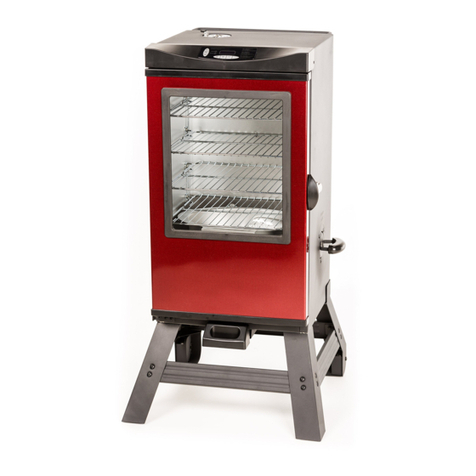
Masterbuilt
Masterbuilt 20076716 manual

Weber
Weber SMOKEY MOUNTAIN COOKER 63230 user manual

Dansons Group
Dansons Group Pit Boss Sportsman 7 Series owner's manual

Pit Boss
Pit Boss COPPERHEAD 3 Series Assembly and operation instructions
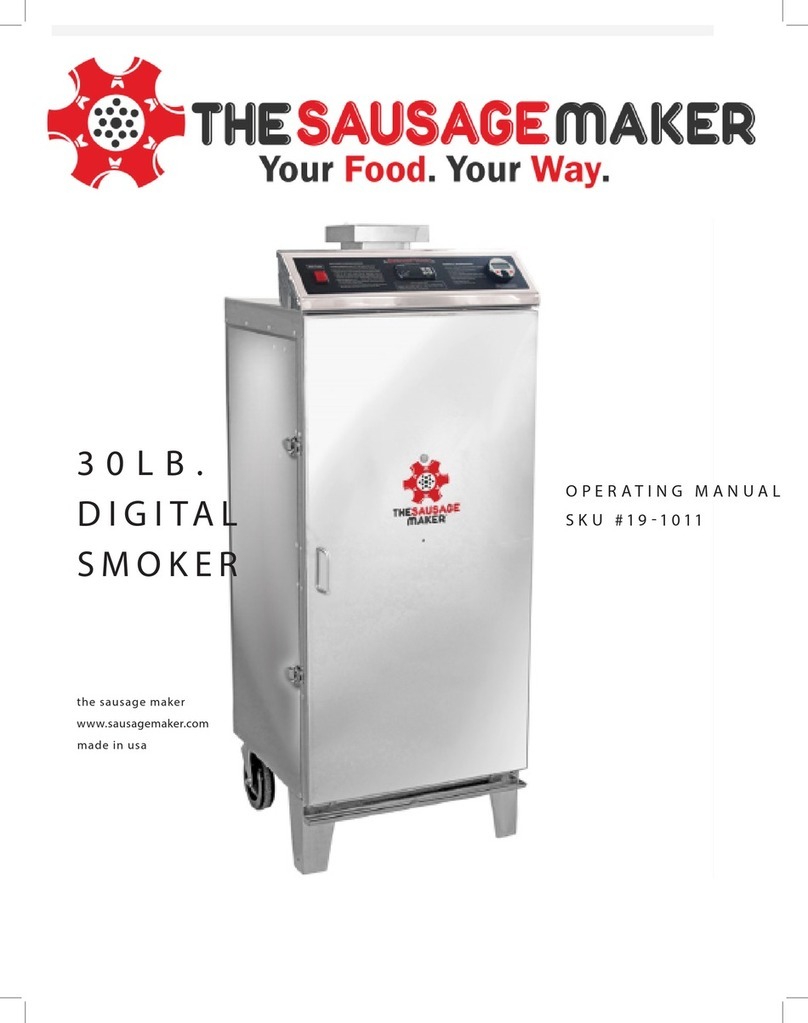
The Sausage Maker
The Sausage Maker 19-1011 operating manual
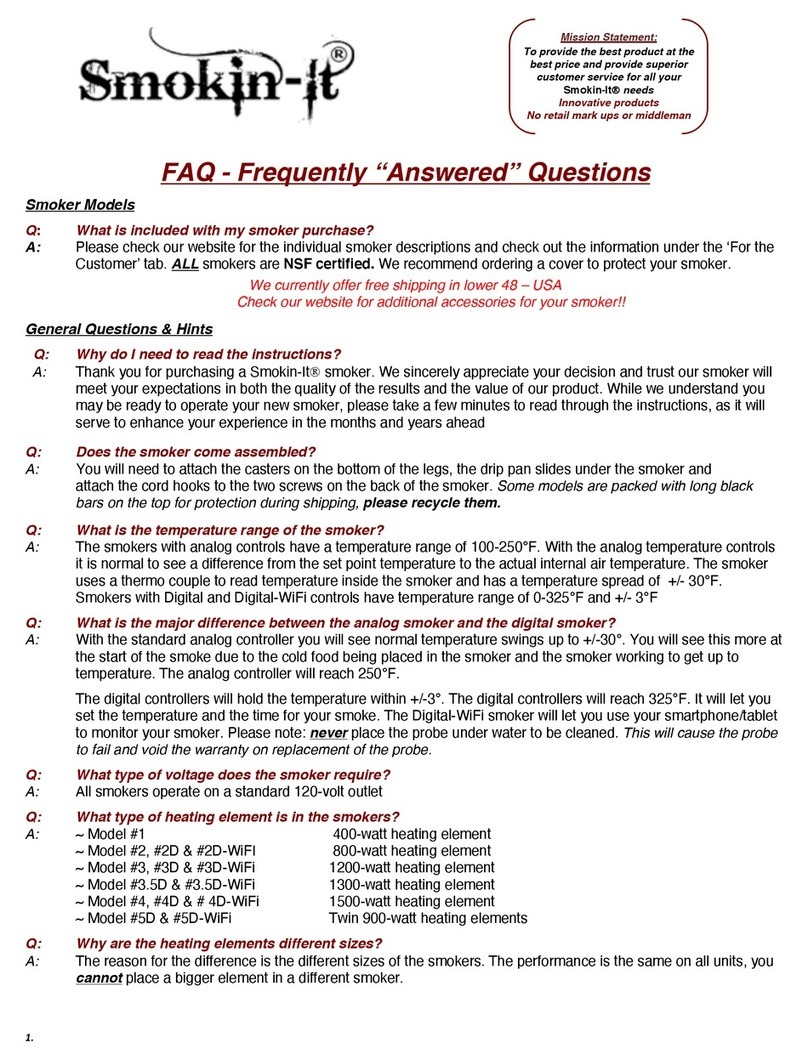
Smokin-It
Smokin-It D 3 Faq

